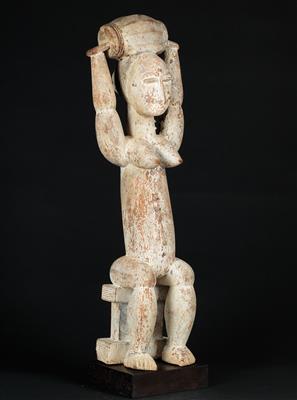Atié, Ivory Coast: A large, seated female figure carrying a vessel on her head. Coloured in white.
Atié, Ivory Coast: A large, seated female figure carrying a vessel on her head. Coloured in white.

The Atié belong to a group of small ethnicities, the so-called ‘Lagoon people’, on the eastern shore of the Ivory Coast. Like the Ebrié, Agni, Alangoa and others. The sculpture shown here embodies the typical style of the Atié: mostly female figures with rounded, sturdy forms, oval faces with sharp-edged, long noses, slit eyes in the form of coffee beans, and a small mouth. Shoulders and hips appear broad, the rest of the body relatively long. The women frequently carry an object on their heads, as in this case a sort of barrel. A particularity in the female figures of the Atié are the dotted scarification marks on the entire body. They are made by inserting small wooden spikes into pre-drilled holes. This feature also appears in the present item: in the face on the forehead, on the temples and cheeks, on the neck, on the pointed breasts, in a vertical row above and below the emphasised navel, as well as along the dorsal line (here two spikes are missing). The woman sits on a stool, which is decorated with relief lines. The seated female figure presented here is carved out of light-coloured, hard wood and displays, in addition to the classical style of the Atié, a special feature: she is coloured in white. Normally, the sculptures of the Atié are black or brown. According to the information provided by the consignor, white-coloured Atié figures are very rare: they ought to belong to sooth-sayers, magicians and healers. And the white colour, perceived as beautiful, should attract invisible spirits, so that these ‘religious specialists’ of the Atié society can come into contact with the spirits. At least, this is the verbal explanation of the consignor. The present figure is old, and was in use for a long time. It displays a good, smooth, shiny patina and some age-related damage: older, partially over-painted breaks at the back on the barrel, on the back of the head, and under the left arm of the figure. In addition, cracks on the left side and on the stool. Heavy colour scuffing, broken toes and two missing tattoo spikes on the back. H: 72 cm. First half of the 20th century. (ME)
Provenance: Belgian Private Collection.
Lit.: ‘Les Maitres de la sculpture de Cote d’Ivoire’ by Eberhard Fischer & Lorenz Homberger, fig. 76, 77 (a very similar, but brown Atié figure).
Expert: Prof. Erwin Melchardt
 Prof. Erwin Melchardt
Prof. Erwin Melchardt
+43-1-515 60-465
erwin.melchardt@dorotheum.at
02.11.2015 - 14:00
- Vyvolávací cena:
-
EUR 2.500,-
Atié, Ivory Coast: A large, seated female figure carrying a vessel on her head. Coloured in white.
The Atié belong to a group of small ethnicities, the so-called ‘Lagoon people’, on the eastern shore of the Ivory Coast. Like the Ebrié, Agni, Alangoa and others. The sculpture shown here embodies the typical style of the Atié: mostly female figures with rounded, sturdy forms, oval faces with sharp-edged, long noses, slit eyes in the form of coffee beans, and a small mouth. Shoulders and hips appear broad, the rest of the body relatively long. The women frequently carry an object on their heads, as in this case a sort of barrel. A particularity in the female figures of the Atié are the dotted scarification marks on the entire body. They are made by inserting small wooden spikes into pre-drilled holes. This feature also appears in the present item: in the face on the forehead, on the temples and cheeks, on the neck, on the pointed breasts, in a vertical row above and below the emphasised navel, as well as along the dorsal line (here two spikes are missing). The woman sits on a stool, which is decorated with relief lines. The seated female figure presented here is carved out of light-coloured, hard wood and displays, in addition to the classical style of the Atié, a special feature: she is coloured in white. Normally, the sculptures of the Atié are black or brown. According to the information provided by the consignor, white-coloured Atié figures are very rare: they ought to belong to sooth-sayers, magicians and healers. And the white colour, perceived as beautiful, should attract invisible spirits, so that these ‘religious specialists’ of the Atié society can come into contact with the spirits. At least, this is the verbal explanation of the consignor. The present figure is old, and was in use for a long time. It displays a good, smooth, shiny patina and some age-related damage: older, partially over-painted breaks at the back on the barrel, on the back of the head, and under the left arm of the figure. In addition, cracks on the left side and on the stool. Heavy colour scuffing, broken toes and two missing tattoo spikes on the back. H: 72 cm. First half of the 20th century. (ME)
Provenance: Belgian Private Collection.
Lit.: ‘Les Maitres de la sculpture de Cote d’Ivoire’ by Eberhard Fischer & Lorenz Homberger, fig. 76, 77 (a very similar, but brown Atié figure).
Expert: Prof. Erwin Melchardt
 Prof. Erwin Melchardt
Prof. Erwin Melchardt
+43-1-515 60-465
erwin.melchardt@dorotheum.at
|
Horká linka kupujících
Po-Pá: 10.00 - 17.00
kundendienst@dorotheum.at +43 1 515 60 200 |
| Aukce: | Mimoevropské a domorodé umění |
| Typ aukce: | Salónní aukce |
| Datum: | 02.11.2015 - 14:00 |
| Místo konání aukce: | Wien | Palais Dorotheum |
| Prohlídka: | 28.10. - 02.11.2015 |
